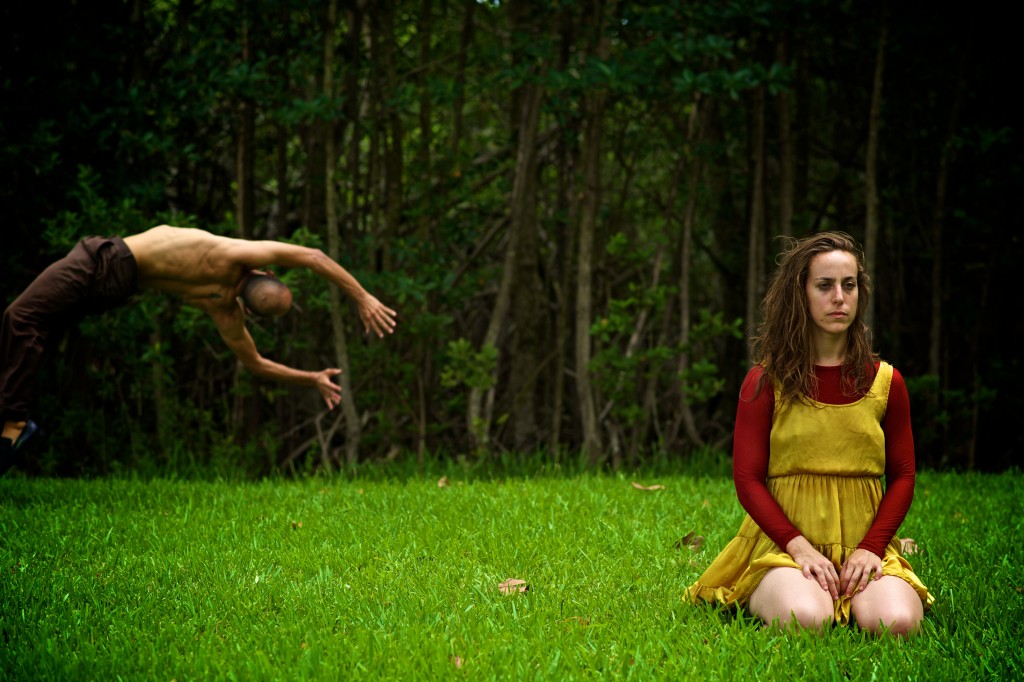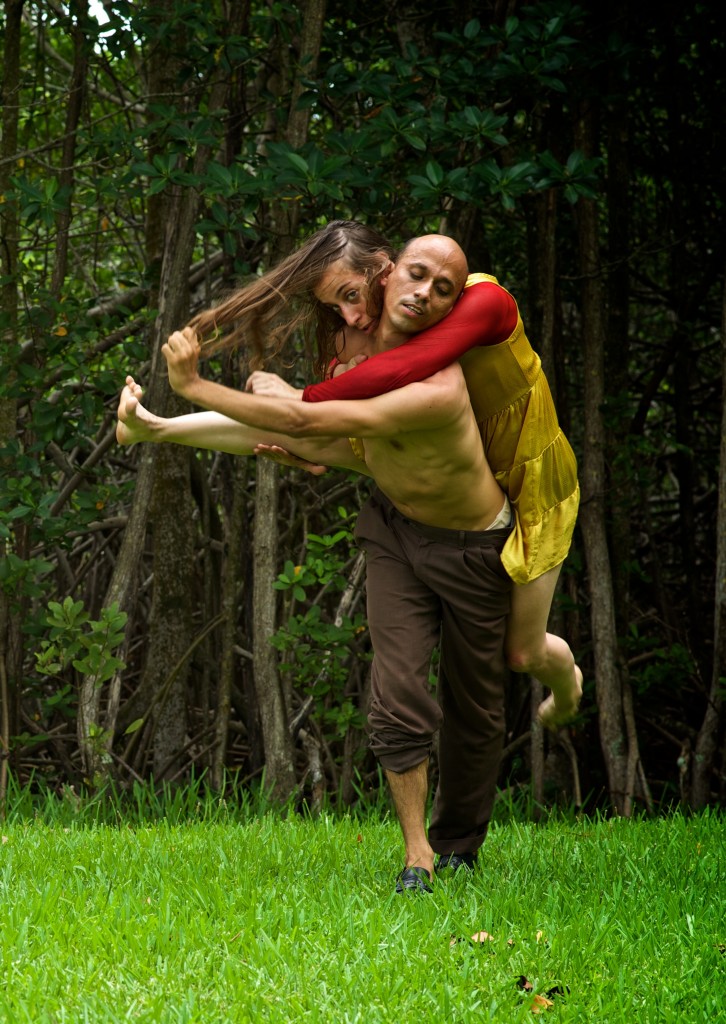
Carlota Pradera gives us “Bare Bones”
Carlota Pradera returns to the Miami Theater Center as part of its 2013-2014 SandBox Series for the premiere of “Bare Bones,” an experimental dance performance featuring special guest artist Lazaro Godoy, who has just returned after a few years performing in Israel. I sat down with Pradera & Godoy on floor of the SandBox Theater and we spoke about “Bare Bones;” the themes of alienation, fear and love that inform the project; and the cost of being an artist in a city that lacks a vibrant public transportation system.
How do you entice people to experience the experimental which, by its very nature, often scares audiences?
LAZARO GODOY: I’m always conscious of giving people an experience that they wouldn’t be able to experience on their own. Art is about communication and exchanging ideas—bringing things to the table. Making people feel welcome. People have to be able to relate and we want people to kind of enter the piece.
CARLOTA PRADERA: I used to dare audience to enter the work. Now, I’m slowly shifting away from daring them to enter and more toward communication. People are coming to communicate with us, not be challenged. They bring this other energy and we’re more on the edge and it becomes more real when an audience is there.
Tell us about Bare Bones.
CP/LG: It’s hard work. It’s hardcore. Laborious. Impossibility. Black hole. Poetic images from Juan Carlos Zaldivar. It’s about building a bridge and how can we build something together that is not a wall. Bare Bones deals with feelings of frustration and human inadequacy. There’s a frustration, this feeling deep in us that we are incapable of succeeding. We want to build a bridge to communicate and create the illusion of paradise. We (falsely) believe things will be beautiful on the other side—of the bridge, the wall, of life—but we’re arguing that it is beautiful and difficult here and now on this side. This is paradise.
CP: For me, Bare Bones is about confronting oneself. Confronting the things that don’t work. Accepting things for what they are. Being realistic. Unleashing the animalistic layers. Hopefully, we find our child, lost child, our references from the past. Working with memories. Bringing back places where I’ve lived.
You just returned to Miami a few months ago. What is it about Miami that frustrates you?
LG: There’s something in me that’s sad because I graduated from New World School of the Arts, but then I left. I’m back now and I love it, but I’m starting from zero. Everywhere you go, you have to give a bit of yourself and adjust to the place. Since I returned to Miami, I feel tight. Like I’m not capable to go beyond some invisible barrier. In Israel, I was reminded of who I was. There’s something pushing artists and humans to be sensitive and constantly search and explore—that was the life I experienced in Israel. I want to bring a bit of that here. Somehow I was very connected to the culture even though I’m not Israeli. Everyone was an artist. There was always a way to express yourself. Israel was very open. I remember there was a street project that I participated in, and it was well-received. It involved Sudanese refugees. We started to dance with them and people would look at us oddly for a second, and then they seemed to quietly accept the performance. But here, in Miami, I don’t feel it would be accepted here—creating a piece like that on the streets or at airport. I’m not sure I’d dare to do it here, but I want to open Miami up to it.
Photo by Alexey Taran from Bistoury Physical Theatre and Film
The work questions divisive lines of man-made borders that alienate families, lovers, friends and political enemies. It examines the distance invading our cultures and social behaviors, creating a world in which touch is becoming an endangered sense and fear is becoming the predominant vehicle for communication. What does this particular project mean to you individually?
CP: The absurdity and the continuity of fear, which is becoming the predominant vehicle for communication. During the performance, it takes time for us (the two dancers) to meet. It takes time to connect and realize we’re the same…
LG: The moment that they meet with their heads. Part of me is inside of you and vice versa.
CP: No matter what, you’re always going to have that moment when it touches you. That’s part of it. It’s not always happy happy. “Bare Bones” examines that.
LG: For me, there are stories from memory: fighting fish. The memory of learning something hard. One day I went fishing and caught a bunch. I took them back home and shared them with my friends. Eventually, I put the last two in a small space together. They held each other in the mouth. I thought they were kissing, but they were fighting. One fish rose to the top. One fish sank to the bottom, dead. This comes out in the work through conflict and physicality. Eventually, we become one, but it takes work. It’s a paradox—there’s passion and love, but at the same time we hurt each other.
CP: Winning and losing. I don’t fee like that. It’s more complex. You want to, at the end of your life, know what it meant. It’s purpose, settled. I don’t know if we change, but things change. I’m not the same person I was when I was 13. “Bare Bones” deals with these changes.
What has your experience been like with SandBox Series?
CP: It’s been a great opportunity to present work and to work with an amazing team of artists, such as Lazaro Godoy, Cuban filmmaker and video artist Juan Carlos Zaldivar, lighting designer Alexey Taran and sound artists/composers Juraj Kojs and Rainer Davies, who created a live soundtrack.
The SandBox allowed all the elements to come together to help me create something solid—and have something to say. We’re gonna be present. For me, I’m thankful Lazaro is pushing buttons. I’m really being challenged as an artist. I have to trust and go to places that are not easy. Choices that I make as a mover. The way I move. The patterns I’ve gotten used to as an artist are breaking away. At times I’m very insecure, but I also know that they’re valuable. Because of this experience, we’re going to become better artists.
“Bare Bones” runs June 13-28 on Friday and Saturday nights at 8 p.m. in MTC’s SandBox, a 50-seat black box studio adjacent to its MainStage, 9806 NE 2nd Ave., Miami Shores. View Pradera’s Hatchfund project proposal here. SandBox’s “Discovering Movement” Workshops will take place from 7-9 p.m. on the following Wednesdays: May 21 and 28, and June 4, 18 and 25. $80 for five sessions.
Recent Content
-
Artsarticle ·
-
Artsarticle ·
-
Artsarticle ·

